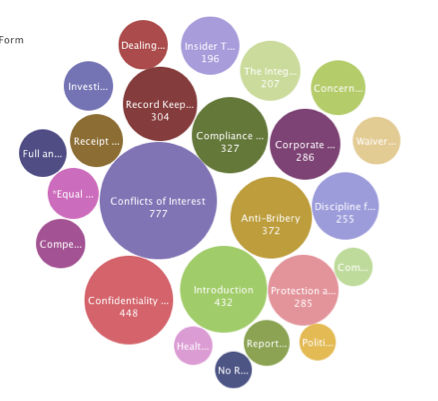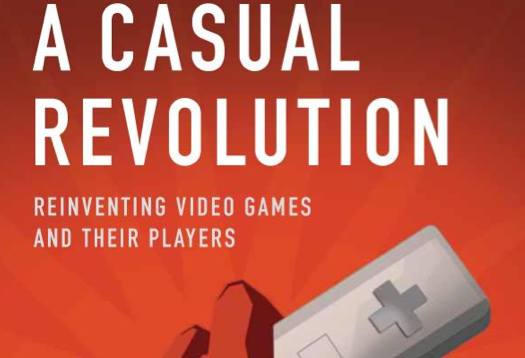- This is a visualization based on word frequency. It has not been adjusted in any way.
For my diss, I am using a two-pronged approach for analyzing gaming industry company policy. The first is a hermenuetic analysis and the second is a visual analysis. Using various methods of data visualization and postmodern mapping, visualizing company policies have been an invaluable source of information about 1) what companies find valuable and 2) the way companies have chosen to present themselves in the public sphere (all of the documents I analyze are public). While these maps don’t give much context to the usage of the terms represented, they do show a snapshot of the language used to describe how employees should behave. This doesn’t paint a complete picture, far from it, but does provide one interesting point of view.
I move forward with my analysis of company policy documents under three primary assumptions:
1. Company policies reflect the way “the company” (whether this means the CEO, the Board of Directors, or some unseen entity is up for debate) desires its employees to act.
2. Company policies are a major part of the narratives that institutions shape about themselves.
3. Formal, documented policies are often the last refuge for those who are discriminated against, harassed, ignored, or otherwise abused.
Readers may disagree with some of these assumptions, but they nevertheless ground my analysis. This may indeed be only a first step, but it is an important one in the move to encourage scholars of technology to intervene in communities that foster exclusion and mistreatment of those who are not in power. In fact, rarely has work dealing with cultures remained armchair, dealing with only hypotheticals. Work and theory on gender likewise has a tradition of intervention, from Judith Butler’s work with bodies to Barad’s work with quantum mechanics. This study follows in those traditions by asserting that it is our place question the treatment of disenfranchised within the technoculture and strive to make it better. Finding my way in through public policy documents has turned out to be both productive and useful, though it is by no means complete.
The words most used in Blizzard’s Employee Code of Conduct are “company,” “information,” “code,” “employees,” and “must.” While this does only show the frequency of words used, not necessarily what the company values, it seems reasonable to argue that this does suggest that Blizzard’s lexicon favors a kind of corporate speak, where individual employees are not featured as prominently as the company overall. Considering that Blizzard is one of the top three largest video game companies, competing with Sony Online Entertainment and Electronic Arts[1], this makes sense. They made 4.86 billion dollars in 2012, growing by just over 2%, and boast over 6,700 employees. Much different than a company like Riot games, which I’ll analyze next week, Blizzard is an enormous company and this is reflected in the employee code of conduct.[2]
Sexual harassment is not discussed in the code of conduct, nor is abuse or harassment of any kind. It is certainly possible, perhaps even likely, that the details of employee conduct when it comes to things like sexual harassment, behavior at conferences, and public social media interactions are detailed in other, internal documents. However, the documents provided to the public are still a rich source for ascertaining the image or story that Blizzard wishes to portray about itself. Only one sentence is provided that discusses the company’s policy on gender, race, and sexual orientation:
“Each of us has a fundamental responsibility to show respect and consideration to our fellow employees. The diversity of the Company’s employees is a tremendous asset. We are firmly committed to providing equal opportunity in all aspects of employment and will not tolerate any illegal discrimination or harassment of any kind. It is the policy of the Company to provide equal opportunity in employment (including in recruiting, hiring, transfers, promotions, compensation, benefits, discipline and termination) to qualified individuals regardless of race, color, age, religion, gender, national origin, pregnancy, marital status, sexual orientation, physical or mental disability, military status, and all other grounds of discrimination provided by local legislation” (3).
Clearly, this is a stock line of legalese, not a heartfelt defense of diversity. The next line states that if an employee has further questions regarding this policy to contact their local HR rep. This is typical in many companies, which suggests a number of possibilities with regards to the company’s view of diversity and harassment.
- The company does not anticipate that harassment and discrimination will not likely be a problem.
- The company has chosen to only provide the bare minimum protection required by law for their employees.
- A severe lack of diversity in the current workforce obscures policies about diversity and discrimination from even showing up as a topic of importance.
- The company truly believes that this is all that is required to adequately protect their employees.
I do not know which one, if any, of these are the impetus for the lack of policy. However, when 1/8 of the policy is dedicated to conflicts of interest, 1/8 is dedicated to confidentiality, and an entire section is dedicated to proper use of company assets, it is telling that only one paragraph even mentions harassment, gender, discrimination, or procedure to follow when one feels harassed, abused, or discriminated against.

*Equal Employment and Working Conditions is the only section that discusses gender, race, or discrimination. Harassment is not mentioned in the Code of Conduct.
The lack of sexual harassment policies, and the lack of acknowledgment that it is a problem, is fairly pervasive. The ADA Initiative, as we have talked about numerous times on the blog, is dedicated solely to promoting the inclusion of sexual harassment policies at industry conferences. While it may seem bizarre that policies like this aren’t already present, conferences in our own field, such and Computers and Writing, didn’t have a sexual harassment policy until this year (after an incident occurred). This is telling of who is thought to exist in these tech-heavy environments.





2 thoughts on “Analysis of Blizzard Inc. Employee Code of Conduct”
While it may not pertain directly to what you’re doing in your thesis, it might be interesting to compare and contrast this code of conduct to how Blizzard deals with race, gender, sexual orientation, etc. outside the company. One good example with lots of documentation might be when Blizzard reprimanded guilds for openly recruiting LGBT members. Guilds like Stonewall Champions and Spreading Taint on the Proudmore server were punished fro violating the WoW EULA by even advertising sexual orientation as a criteria (in a sort of reverse discrimination policy). So for all the homophobic banter in the game, this incident remains one of the most highly publicized instances where Blizzard took any position on game play and sexual orientation in relation to its customers.
Just an idea of how these things get enacted in the public, not sure how you’d find out what happens internally without risking someone’s job.
My analysis part is specifically focusing on publicly available corporate policies, but I could definitely use that for showing a possible link between the policy and the behavior. As Blizzard seems it is unimportant to protect their employees from harassment or even pretend to be open minded, it doesn’t surprise me that they stifle players who want to do things like create safe spaces. If you have any sources on this, definitely shoot them my way. I’ve been struggling with how to end each analysis, and a nice (horrible) anecdote might be just the thing. Thanks Don!